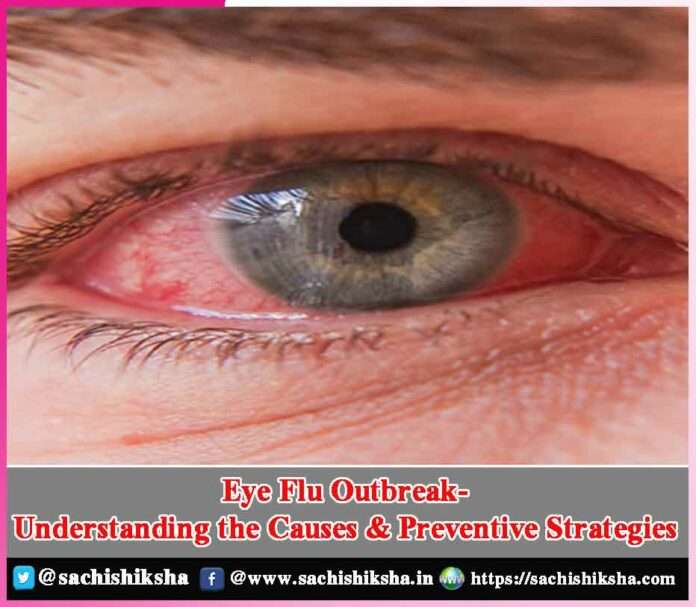Eye Flu Outbreak- Understanding the Causes & Preventive Strategies
Introduction: When the monsoon season approaches, it additionally delivers solace from the blazing heat, but it also carries with it a slew of infections and ailments. The combined effect of moist conditions and water that is stagnant fosters the growth of many ailments,
presenting an important risk to human health. Amongst the most prevalent monsoon-related diseases is eye flu, sometimes known as conjunctivitis. This extremely contagious disease can cause irritation and itching, prompting many people to look into helpful home treatments for healing.
Also Read:
- Some Do’s & Don’ts of Networking Business
- New Parents Learning the Parenting Business
- Basics of Stock Market
- Is War the Only Solution For Peace?
- Rehabilitate Yourself Within
- Be Trustworthy
Table of Contents
Negligence of the Eyes:

Misconceptions Regarding Eye Flu:
During the rainy season, fungal and bacteria-related illnesses are common, and eye flu is one of the consequences. This disorder can be caused by viruses, bacteria, allergies, and influences from the environment. We will look at the signs and symptoms of eye flu, as well as its causes and treatment alternatives. This prevalent eye illness, also known as ‘pink eye,’ has been linked to various misconceptions, none of which should be believed.
A common misconception is that you may become diseased simply through gazing into the eyes of someone who is afflicted, which is not accurate. If you feel an itchy sensation, irritation, or discomfort in your eyes, as well as redness, see a doctor. Another common misconception is that conjunctivitis can only be contracted by scratching one’s eyes. This nevertheless is not what is happening. It spreads in your eyes regardless of when you touch them with contaminated hands.
Common Cause of Eye Flu:
This eye disease is caused by viruses and can cause the lenses of your eyes to become itchy, painful, and watery. It might also cause a viscous substance and discomfort in your eyes. It is infectious, which implies that it can readily spread from one individual to another person. One could get it by rubbing the eyes after handling things that have been contaminated with the virus, or by coming into intimate proximity with another individual who has this eye issue.
This flu generally occurs by an infection with a viral organism. Adenoviruses enter viruses, and the herpes simplex viruses are some of the most frequent viruses that cause conjunctivitis. These are easily transmitted through direct touch, droplets in the air, or infected objects; however, particular risk factors such as overcrowding, inadequate sanitation practices and weakened immune systems can increase the chance of spreading to a greater extent.
Symptoms of Eye Flu
Itching and Redness:
The basic indications of eye flu are redness and discomfort. The irritation of the conjunctiva of one’s eyes causes it. The blood vessels in the eyes expand, making them seem pink.
Individuals can experience itching, scratchiness, or a foreign body appearance in their eyes. These signs are more obvious first thing in the morning or after an extended period of sleep.
Watering Eyes:
Other frequent eye flu symptom is extra generation of tears, which results in wet or tearful eyes. The primary root cause of watery eyes is conjunctival irritation, which may activate the tear glands and cause an excess of tears. Watery eyes can cause irritation and blurring of vision, leaving it difficult to carry out regular tasks.
Sensitivity to Light:
Photophobia, an issue in which the eyes become reactive to light, can happen to those who have the eye flu. Contact to bright illumination or the sun can induce blurred vision and agony, causing people to grimace or hide their eyes from sources of light.
Eyes discharges:
A heavy, viscous discharge from the eyes upon getting up is a prevalent sign of bacterial conjunctivitis. The discharge is frequently yellow or greenish in colour and can cause the skin around the eyes to cling together. A watery or transparent discharge from the eyes can additionally be caused by viral conjunctivitis.
Feeling of Grittiness:
Certain individuals who have eye flu may experience a scratchy or sandy sense of touch, as if there is debris in their eyes. This granularity is frequently connected with conjunctivas irritation.
The Scratching of the Eyelids:
The discharge may become sticky and solidify overnight in instances of bacterial conjunctivitis, producing layers around the eyelids. Because of the existence of these crusts, people may have difficulty in opening their eyes when they wake up.
The swelling in lids:
Inflammation of the eyelids is a probable indication of eye sickness, which is caused mostly by sensitivities. Conjunctivitis caused by allergies can cause eyelid oedema, which causes the eyes to seem puffed and dilated.
Uncomforting When Seeing:
Because of the infection of the conjunctiva, those suffering from eye flu may experience stiffness or agony when blinking. Blinking might aggravate the irritation and make it worse.
Eye Fluid Transmission:
The transmission of flu in the eyes is determined by the root cause of the illness. Viral and bacterial conjunctivitis are very contagious and can be transmitted from human to another via intimate contact in addition to the use of respiratory drops. Allergic conjunctivitis, on the contrary hand, is not contagious and does not transmit from individual to another.
Precautions to be Taken:-
Employ Tissues Wisely and Correctly:
To prevent touching directly with your eyes, utilize a tissue. Quickly place used tissues in a tight container and clean your hands.
Wash Your Hands Frequently:
Adequate hand hygiene is crucial in preventing the spread of ocular flu. Always remember to clean your hands periodically with soap and water for a minimum of 20 seconds, especially after touching surfaces that are shared such as staircases, the doorknobs and chairs while utilizing public transit. Carry a travel-sized hand disinfectant for the occasional need to sanitize your hands.
Keep Your Hands off Your Face:
While on public transportation, do not touch your face, particularly your eyes, nose, and mouth. Interaction with polluted droplets from sneezing or coughing can spread conjunctivitis, and caressing your face can allow the virus to make its way into your system. To keep one safe, maintain vigilance.
Wear Eye Protection:
Whenever taking public transportation, think about wearing sunglasses or glasses with a prescription. These can function as an inhibitor against airborne debris and keep your eyes from coming into close touch with probable carriers of illness.
Keep Appropriate Distances:
To reduce your chances of contracting conjunctivitis or other hazardous infections, maintain a safe distance from those who are displaying indications. Furthermore, avoid crowded environments and keep out contact with anybody who may be contaminated. This can assist to reduce your overall risk.
Use of Personalized Items That are Clean:
To limit the chance of infection, sterilize and clean objects you frequently touch, such as your phone, spectacles, or pocketbook, on frequently.
Improve Your Defenses Against Infection:
A healthy immune system might help you avoid illnesses. To help your immune system, consume a well-balanced diet, workout often, remain well-hydrated, and get sufficient sleep.













































